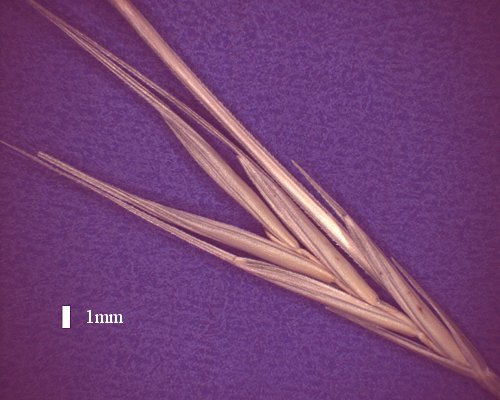 |
 |
|
 |
 |
|

Elymus multiflorus (Banks & Sol. ex Hook.f.) Á.Löve & Connor |
Common name
Short awn wheatgrass
Derivation
Elymus L., Sp. Pl. 83 (1753); from the Greek Elumos, old
Greek name for a kind of grain.
multiflorus- from the Latin multus (many) and flos (flower). Spikelets with more florets than those of related species.
Published in
New Zealand J. Bot. 20: 183 (1982).
Habit
Perennial, densely tufted. Young shoots intravaginal. Culms erect or geniculately
ascending, 16–70 cm tall. Leaf-sheath auricles absent, or present. Leaf-sheath
auricles 0–1.9 mm long. Ligule an eciliate membrane, 0.3–0.6 mm long,
membranous, truncate. Collar glabrous. Leaf-blades erect or drooping, flat,
4.1–28.5 cm long, 1.8–6.8 mm wide, mid-green. Leaf-blade surface scaberulous.
Inflorescence
Inflorescence solid, a raceme, comprising 3–18 fertile spikelets. Raceme
1, bilateral, 7–15 cm long, bearing (3–)6–11(–18) fertile
spikelets. Rhachis flattened, scabrous on margins. Spikelet packing broadside
to rhachis. Raceme internodes linear. Raceme internode tip flat.
Spikelets
Spikelets solitary. Fertile spikelets many flowered, comprising 6–12 fertile
florets, with diminished florets at the apex, elliptic to oblong, curved, laterally
compressed, 10–39 mm long, breaking up at maturity. Spikelets disarticulating
below each fertile floret. Rhachilla internodes pilose, with 1–2 mm long
hairs. Floret callus bearded.
Glumes
Glumes persistent, similar. Lower glume subulate or lanceolate or ovate, 8–10
mm long, 90% length of upper glume, chartaceous or coriaceous, 3–7-nerved.
Lower glume apex setaceously acuminate, muticous or awned. Upper glume lanceolate,
8–10 mm long, coriaceous, 3–7-nerved. Upper glume apex setaceously
acuminate.
Florets
Fertile lemma lanceolate or elliptic or oblong, narrowly proportioned, 6.5–13
mm long, coriaceous, keeled above, 5-nerved. Lemma surface scaberulous, rough
above. Lemma apex acute, muticous or mucronate or 1-awned. Median (principal)
awn 1–16 mm long overall. Palea 100% of length of lemma, 2-keeled.
Palea keels scabrous, ciliolate. Apical sterile florets resembling fertile though
underdeveloped. Lodicules 2, membranous. Anthers 3, 1.4–5 mm long, purple.
Stigmas 2. Grain with adherent pericarp.
Continental Distribution:
Australasia.
Australian Distribution:
Queensland, South Australia, New South Wales, Victoria, Tasmania.
Queensland: Leichhardt, Burnett, Wide Bay, Darling Downs, Moreton, Warrego, Maranoa. South Australia: Flinders Ranges. New South Wales: Central Coast, South Coast, Northern Tablelands, Central Tablelands, Southern Tablelands. Victoria: Riverina, Gippsland Plains, East Gippsland. Tasmania: East Coast.
Classification. (GPWG
2001):
Pooideae: Triticeae
Notes
Native. Found in SE Qld, eastern N.S.W., Vic, S.A. and Tas., usually from sand
dunes of foreshore, river bank, or some inland area. Also in New Zealand. Specimens
from coastal area of N.S.W., Vic., S.A., and Tas. differ from those from inland
of northern N.S.W., and SE Qld.

Spikelet (photo)
© Queensland Herbarium
AQ 663790
by D.Sharp